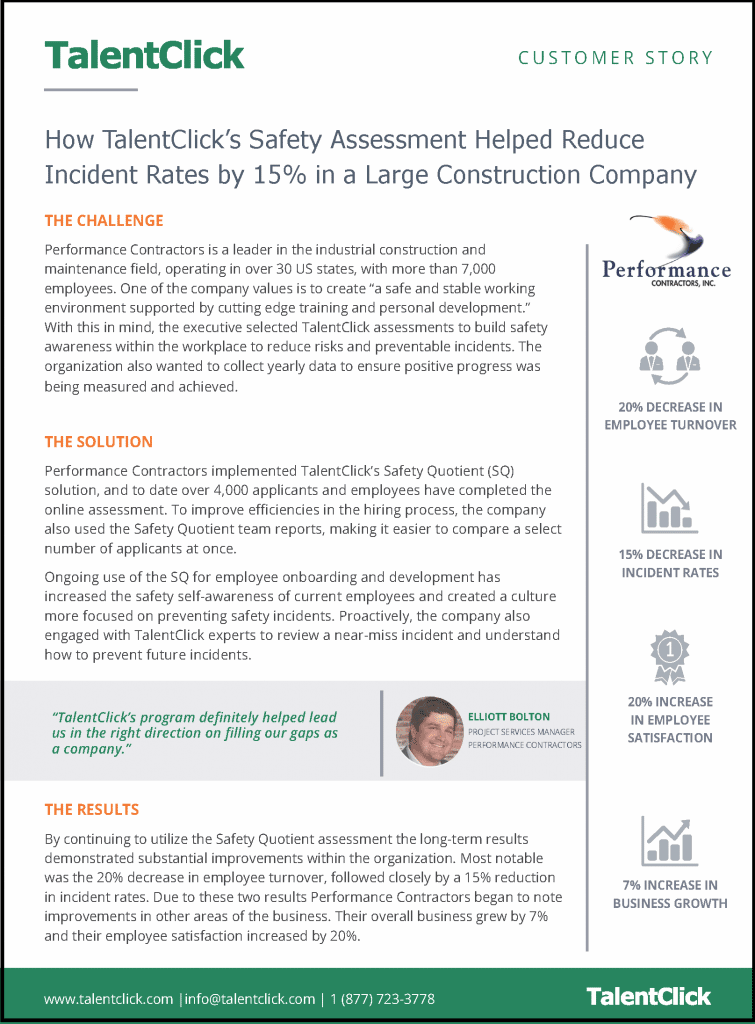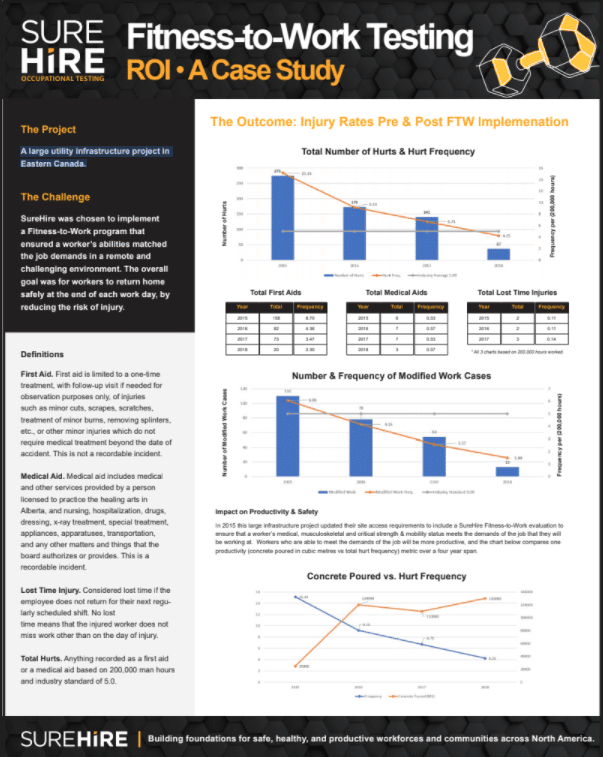TAKEAWAY: Reducing risk in safety-sensitive workplaces can feel like a daunting process. However, there are some powerful strategies employers can use to maximize success!
Jump Ahead
Is safety a priority in your organization? Workplaces with “safety-sensitive positions” face much higher risks than other workplaces, and these elevated risks can be costly. In fact, according to the International Labour Organization (ILO), more than 2.3 million workers die every year as a result of occupational incidents or work-related diseases. The annual cost to the global economy is a staggering $3 trillion. Furthermore, employers will experience added costs such as increased premiums or reduced dividends from their investments because they’ll have to fork out money that could otherwise go towards capital expenditures on equipment upgrades or other necessary business expenses. Another consequence would be high turnover rates caused by a lack of protection due to unsafe conditions at work.
Unfortunately, eliminating safety-sensitive positions from the mix is not an option for many industries. (Learn more in Canada’s Deadliest Industries). Luckily, there are a number of powerful ways employers can mitigate risk and reduce cost.
Pre-Employment Testing and Assessments: Hiring the right people for the job
Pre-Hire Assessments are one of the most effective strategies for creating a strong health and safety culture and building a team that will be safe and productive for years to come. Pre-employment screening can include background checks (employment and education verification, criminal record checks and driver abstracts), behavioural assessments, and more. Even more imperative in the safety-sensitive workplace is the use of pre-employment drug and alcohol testing, fitness-to-work testing, and impairment and safety awareness training.
Background Checks: Make sure your candidates are who they say they are…
Bad hires can cost you. These are the employees who are significantly less likely to stay, waste your investment in onboarding, and add additional recruitment costs to an already expensive process. Bad hires can also put your company at risk for safety violations and even in legal jeopardy.
Background checks can prevent many of these bad hires and the costs that go along with them. In fact, one study pegged the first-year retention rate for employees who underwent background checks at 89% compared to unscreened candidates, whose retention rate often fell below 60%.

Use Behavioural Assessments to Predict Risky Behavior
Knowing the risks your safety-sensitive workers face, and those they might present to others is crucial in reducing company risk. Knowing all employees have some level of “risk” associated with what they do on a daily basis means employers need to take an active role in risk prevention.
Here is an example of how a large construction company reduced their incident rates by 15% by using behavioural risk assessments to evaluate its team. Click to view as PDF.
Develop a Drug and Alcohol Testing Program to Protect Your Workforce
The use of illicit, recreational, and prescription drugs in the workplace can have a drastic impact on the risks associated with safety-sensitive positions. Drug usage has been shown to affect mental capacity, physical capacity, and errors rates on a massive scale. It’s also connected to decreased productivity levels along with an increase in absences from work for workers that fall under this category. Furthermore, Department of Transportation (DOT) employees are bound by strict drug and alcohol testing regulations that can be tricky to navigate for many employers. (Learn more in DOT or Non-DOT Testing?)
Drug and alcohol testing can be a great way to ensure you hire the best people, and random testing can make sure your employees are reliable. Include both in an incredibly comprehensive workplace testing policy that covers all of this information as well as providing impairment awareness training so they understand what it means for them when faced with a positive test result or refusing one outright.

Impairment awareness training (like Reasonable Suspicion Training) is recommended by the Canadian Model for Providing a Safe Workplace.
Implement Fitness-to-Work Testing So You Can Make Informed Hiring Decisions
A strong health and safety culture in an organization isn’t just about having low incident or injury rates. It’s also about instilling a feeling of comfort and security in all workers so they know their organization is doing everything in its power to be able to keep their employees safe at work.
Fitness-to-Work testing acts as a tool for employers to better understand their workforce’s physical capabilities and potential limitations. This creates the opportunity for employers to act in a proactive manner to ensure their workers are in positions that are best suited to their physical and mental capabilities and to appropriately accommodate for potential disabilities, limitations or impairments that might otherwise put the worker or their co-workers at risk of an incident or injury occurring. (Learn more in Fitness-to-Work Testing: What It Is & Why It’s Critical)

Fitness-to-Work ROI: A SureHire Case Study
One of our clients with a large utility infrastructure program in Eastern Canada used our Fitness-to-Work program to ensure worker’s abilities matched the job demands in a remote and challenging environment.
The overall goal was for workers to return home safely at the end of each workday, by reducing the risk of injury. The results were outstanding, and the data speaks for itself. View the case study and connect with us to request a Fitness-to-Work testing quote.
Education & Online Training: Setting your employees up for success
Online education and training is a cost-effective, time-efficient solution for employers looking to invest in their workers’ ongoing professional development. Providing your workforce with access to high-quality course content ensures your employees are getting the information they need to succeed in their roles. Here are some powerful strategies to mitigate risk through education and training.
Combat Fatigue
Fatigue can have far-reaching effects on safety-sensitive workers, but it’s not just the person who gets tired that is at risk. There are a number of hidden costs of fatigue, including effects on decision making and reaction time, which can have harsh consequences for others around fatigued individuals as well. Recognizing the signs and symptoms of fatigue and developing strategies to combat fatigue can be an extremely powerful risk mitigation tool.
Provide Impairment Awareness Training
Many employers overlook the importance of educating their employees about substance abuse and impairment in the workplace. Impairment awareness training (also known as Reasonable Suspicion Training, or drug and alcohol awareness training) is a simple, cost-effective solution. These programs are designed to educate supervisors and employees about the adverse effects of drugs and alcohol on workplace safety. They teach supervisors how to properly document and submit employees for reasonable suspicion testing so legal implications don’t arise. Reasonable suspicion training also offers employees increased understanding of their workplace safety responsibilities and provides direction for confidentially reporting and documenting workplace impairment if it arises.
Promote Safety-Self Awareness
Like golf, safety is a game of continuous improvement; as long as people are required to work in safety-sensitive roles, there will always be obstacles in the way of a purely incident-free environment. Like golf, safety offers unique challenges to overcome on a constant and recurring basis.
The good news is, technology and knowledge have been constantly improving throughout the years. Personal Protective Equipment has become as comfortable as it is effective, automated systems remove the need for many of the more dangerous on-the-job activities, and safety training has become an entire industry on its own, offering a wide range of general and specific courses to keep people safe.
Safety Self-Awareness Training educates participants on how their personalities may contribute to safety risks in the workplace by exploring:
- how personality contributes to workplace incidents and injuries,
- leading indicators of personality risk tolerance:
- Resistant vs. Accommodating
- Anxious vs. Calm
- Impatient vs. Even Tempered
- Distractible vs. Focused
- Impulsive vs. Cautious
- Thrill-Seeking vs. Apprehensive
- personality risk areas in others
- how to adapt their leadership communication styles to each employee to affect behavioural change in the workplace.
Conclusion
Having a clearly defined game plan for reducing risk in safety-sensitive workplaces is critical for business growth, employee wellness, and for developing a safety culture rooted in excellence.
SureHire offers a spectrum of services to help employers mitigate risk and build foundations for safe, healthy, and productive workforces for years to come. We partner with industry experts like TalentClick and Rebel Sleep Institute to deliver risk reduction strategies that work.
Connect with us to find out how we can help you achieve safety culture excellence.

